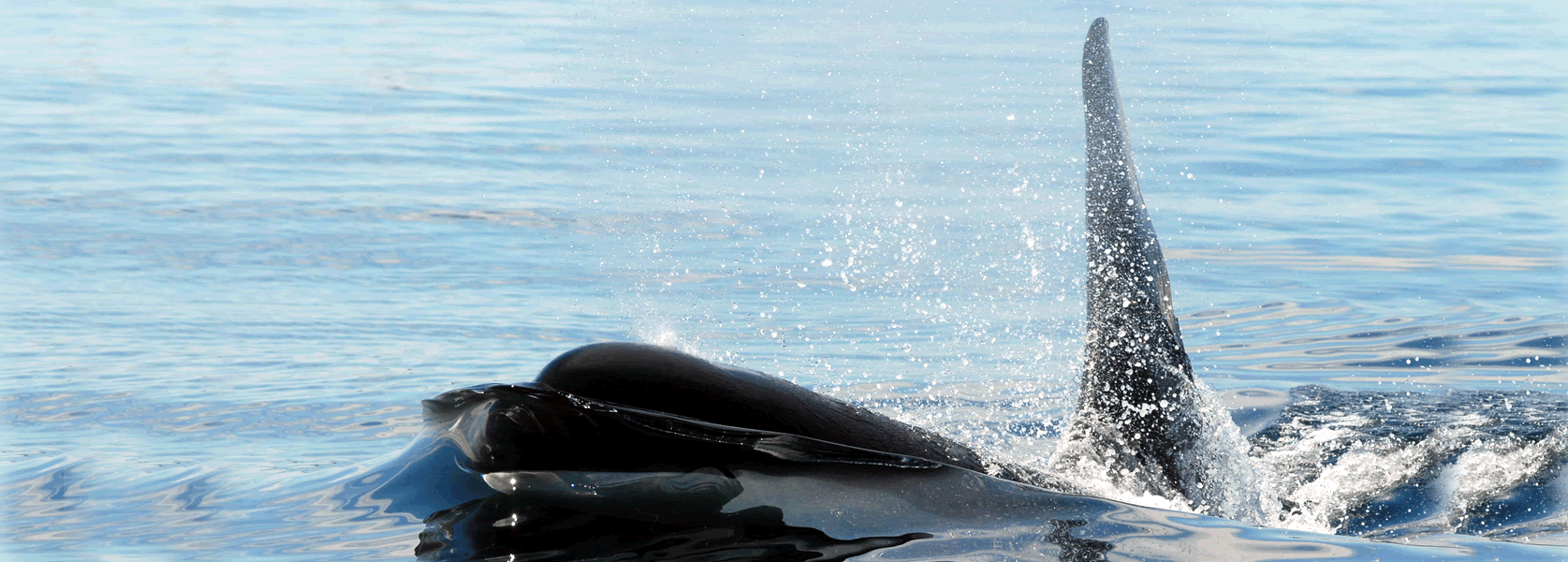Only a few yards separated the two whales from the stern...
— from Center for Whale Research —

L41 – Photo by Dave Ellifrit, Center for Whale Research, 2013
Every whale that passes away is a significant loss, and it is very sad to see how many have disappeared over the past years. But the longer an individual has been with us, and especially when it is an easily recognizable iconic orca, it is even harder.
When I began to help with the Orca Survey in 1987, the population was going up. A death was exceptional in those days. I remember L41 as the young sprouter whom I could tell from L7, because of his slightly taller fin with a nick in the middle. As a 10-year old, he was big for his age. He steadily gained size and weight and grew into an independent and self-confident adolescent.
Perhaps his mother, L11, was less protective. I remember J10 as a female who always kept her young at her side, whereas L11 seemed to have a more relaxed attitude towards her offspring. It looked like she told them: “Feel free to explore the world. If you need me, I’ll be there.” She appeared to encourage him to socialize and build relationships with other individuals early on. Which we now know seems vital for survival when a mom passes away. L41 survived the loss of his mother, probably because he was so well accepted by others in his pod.
One extraordinary event happened on September 14, 1996. Around 7 am, Robin Baird (Cascadia Research Collective) called in a sighting of whales heading north at Hannah Heights. We quickly readied the Center for Whale Research/Earthwatch team and departed Snug Harbor in our trimaran, High Spirits. We saw the orcas abreast at Bellevue Point, heading toward us. There were vocalizations on the hydrophone, and it was evident from the start that the whales were social and active.
The group turned out to be Js and Ls!
Several big males sought each other’s company. We saw J1, J6, L57, and later L38. We turned around and monitored the various J and L groups as they headed north.
When we entered Mitchell Bay, the scene slowed a bit, and we saw a few whales milling at their leisure. We barely moved when we saw a whale hanging in the water close to the boat. In a sort of aerial scan, it held its head a little tilted, and for a moment, we thought it was looking at us. We were thrilled with the attention.
Then, within minutes we suddenly saw adult males converging on us. L57 and L10 approached from portside. J6 came from the starboard side and L41 from behind. The males seemed eager for something and increased speed, creating suction along their flanks.
The whale that had been “looking” at us rolled and dived. We looked around in all directions to see what the males were up to. A few tantalizing minutes of activity went on underwater, out of sight. Then small waves at the stern revealed the presence of approaching whales. We huddled in the back of the boat to watch.
Then, I saw a male and a female whale approach belly up. . . with the giant penis of the male reaching over to the genital slit of the female. Only a few yards separated the two whales from the stern. I made a dash for the throttle to put High Spirits in idle. While we looked down into the water, the pair glided underneath the boat. The penis clearing the prop by only an inch!
Relieved that no harm was done, we watched the two orcas surface in front of us. The mystery was solved: It was L41 and J19.

J19 – Photo by Melisa Pinnow, Center for Whale Research, 2018
We realized that all of the males had been interested in J19, who had been logging beside our vessel. She hadn’t been interested in us at all! Instead, she had been curiously looking around above and underwater as if saying: “Who will it be . . . ?”
Not long after, we saw fog rolling in. Partly in the thin clouds, but just in time, we entered Snug Harbor safely. Still with our minds on the pair in love, the scene passed in revue. Obviously, L41 had won his prize over, as he would do many times to come.
Author’s Note. No calf was conceived during this mating session between L41 and J19. But L41, along with J1, would go on to sire the majority of the calves in the Southern Resident killer whale community. Many are still with us, and hopefully, they will live to carry on the genes of their strong fathers to new generations!
Dr. Astrid van Ginnekenhas been a volunteer CWR staff member since 1987, has published scientific and popular articles about killer whales, and has written a novel,Togetherness is Our Home, An Orca’s Journey through Life, in which killer whales star. She is a data collection and database specialist, is an accomplished wildlife photographer, and is well known for her captivating storytelling of encounters with the charismatic Southern Resident orcas. Dr. van Ginneken lives in The Netherlands.
**If you are reading theOrcasonian for free, thank your fellow islanders. If you would like to support theOrcasonian CLICK HERE to set your modestly-priced, voluntary subscription. Otherwise, no worries; we’re happy to share with you.**








WONDERFUL STORY, and very well told. Thanks
I’ve been thinking on this for a couple of days. The orcas are endangered yet the researchers feel the need to chase them to the point of nearly castrating one while they are trying to reproduce? What’s wrong with this picture? Leave them alone!